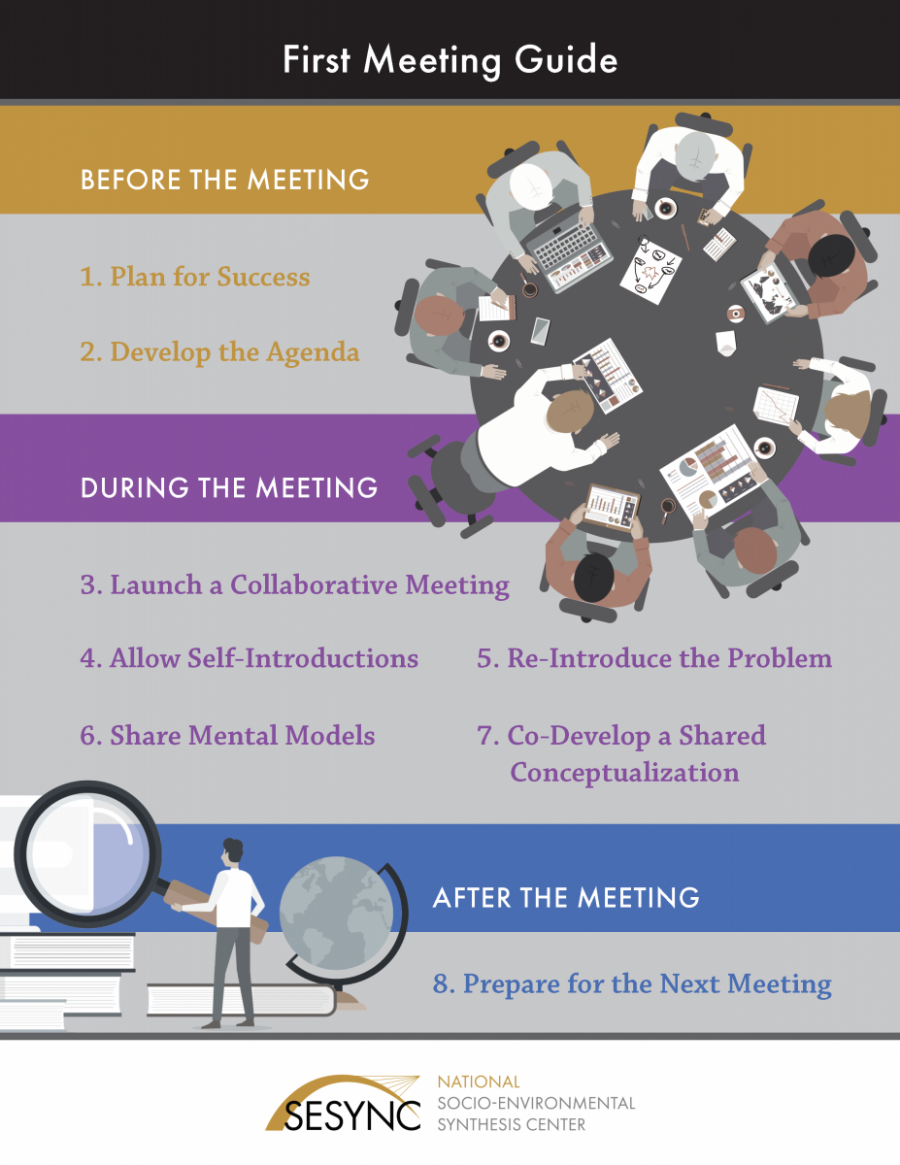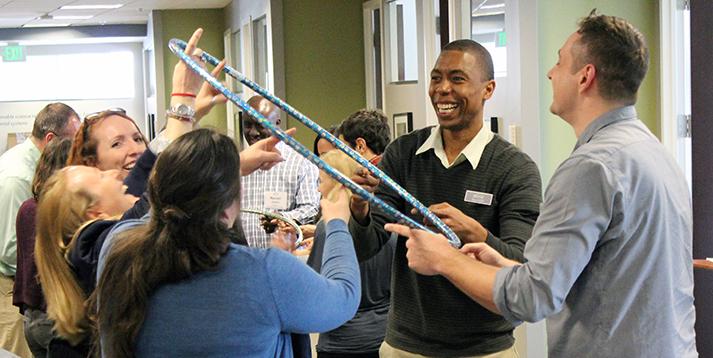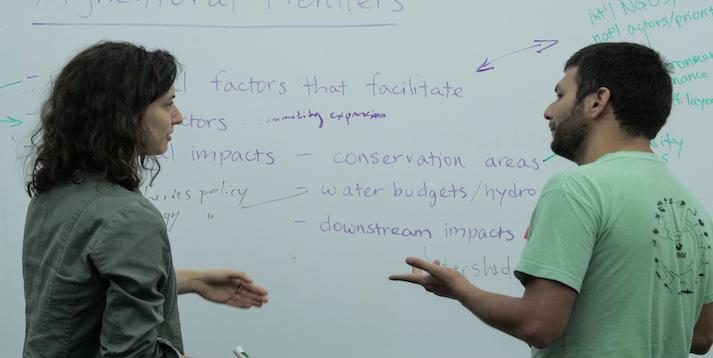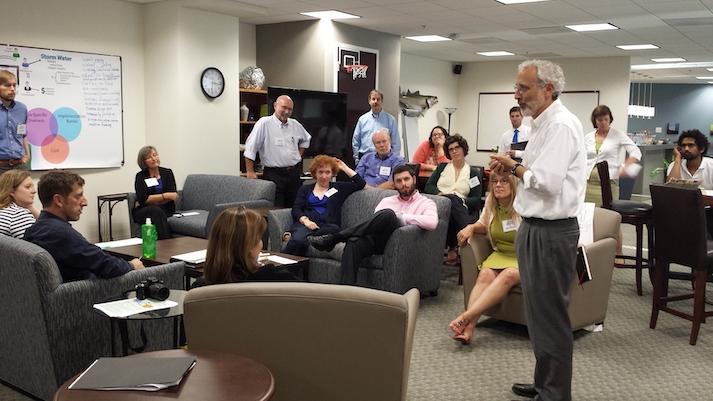Download this guide (see below) for tips on how to structure and make the most of your first interdisciplinary team meeting.
To view in your browser and/or download the guide, click on the PDF below.

Before the Meeting
1. Plan for Success
- Set meeting dates well in advance. Online meetings should be in 2-hour chunks spread throughout a week; for in-person meetings requiring travel, plan for 3 days.
- Share key documents and preliminary plans with the team before meeting.
- Create a shared document, Slack channel, or line of communication to facilitate pre-meeting communication.
- Build rapport between team members and work to understand their perspectives.
- Ask team members to share something about themselves before the first meeting.
2. Develop an Agenda
- Develop an agenda that builds incrementally—session by session, each day, and from one day to the next.
- Focus on specific goals for every session, remembering that a goal may not be to create a specific “product” but to develop shared understanding and familiarity or to build team culture.
- Balance goal orientation with the need for flexibility.
- Seek input from and co-development with team members if possible.
- Include social activities on the first day of the meeting and build in opportunities for social times (e.g., coffee breaks, shared meals, etc.) throughout the meeting.
Image

KEEPING THINGS SOCIALDon’t forget to include social activities in every meeting—but especially the first one. These activities could be a remote or in-person happy hour or coffee break to learn about people as individuals. You can also begin each meeting with a “personal” check-in. Remember relationships matter! |
Image

AGENDA DESIGNInterdisciplinary work that is truly integrative requires collaborators move between periods of comfort and discomfort. Meeting designs should build in time and processes for “leaning into discomfort, rather than withdrawing when misunderstandings arise.” Rebecca Freeth and Guido Caniglia (2020) present a strategy to support and foster this which they call learning to collaborate while collaborating. Read SESYNC’s interview with Rebecca or their full article in Sustainability Science. |
During the Meeting
3. Launch a Collaborative Meeting
- Share roundtable, rapid introductions.
- Use ice breakers that give people a chance to learn something about everyone outside their scientific persona.
- Briefly review what motivated the project, leaving its design for later co-development by the team.
- Discuss the agenda for the day, inviting revisions from the group.
- Establish ground rules to create an environment that is respectful of diverse perspectives and provides a level playing field.
4. Allow Self-Introductions
- Share roundtable, rapid introductions.
- Use ice breakers that give people a chance to learn something about everyone outside their scientific persona.
- Briefly review what motivated the project, leaving its design for later co-development by the team.
- Discuss the agenda for the day, inviting revisions from the group.
- Establish ground rules to create an environment that is respectful of diverse perspectives and provides a level playing field.
- Provide each participant 6–8 to minutes to introduce themselves and their work, allowing time for questions (~2 minutes per participant). Have participants reveal their perspective on why and how the research
problem is important. - Ask each participant to identify their desired outcome (e.g., products, impacts, etc.) from the project.
- Discuss the potentially diverse perspectives of whom might use the knowledge generated from the project’s desired outcomes.
Image

FACILITATING INTERDISCIPLINARY MEETINGSFor more information about how to facilitate your meeting, whether with an external facilitator, or with an internal member of your team taking on a facilitation role, see SESYNC’s: Facilitating Interdisciplinary Meetings: A Practical Guide. |
5. Re-Introduce the Problem
- Re-introduce the problem from the leader’s perspective.
- Explain what motivated the team’s formation.
- Open the problem up for re-definition and iteration.
- Define what matters to each team member (a synthesis of what was stated before).
- Identify where everyone’s skills apply.
- Work on language, explanation, and preliminary insights by creating time and process to explore this at an introductory level
6. Share Mental Models
- Ask each participant to draw a schematic or conceptual model (“mental model”) of the research problem, including their initial assumptions and preferred approach to study it. Also have participants include the problem’s drivers and the factors influencing its resolution. Give members alone time to do this.
- Re-group and have each participant present their schema to the group; allow team members to ask questions, respond, and/or react. Put all the schema into a shared space for group visualization (e.g., online, taped to walls, etc.).
- Encourage the group to discuss commonalities, differences, and terms that need defining; keep notes on the board (e.g., Google Doc, Zoom whiteboard, chalkboard).
7. Co-Develop a Shared Conceptualization
- Guide the group in developing a shared conceptualization of the problem and its desired outcomes based on the day’s earlier discussions. Merge ideas together by negotiating, compromising, and considering shared goals.
After the Meeting
8. Prepare for the Next Meeting
- Review the meeting’s agenda to determine whether or not there is any unresolved business that you should return to next meeting. Consider how the format of this meeting worked and make adjustments as needed for next time.
- Discuss how the project should proceed in between meetings to accomplish outcomes.
- Complete a list of accomplishments from the meeting.